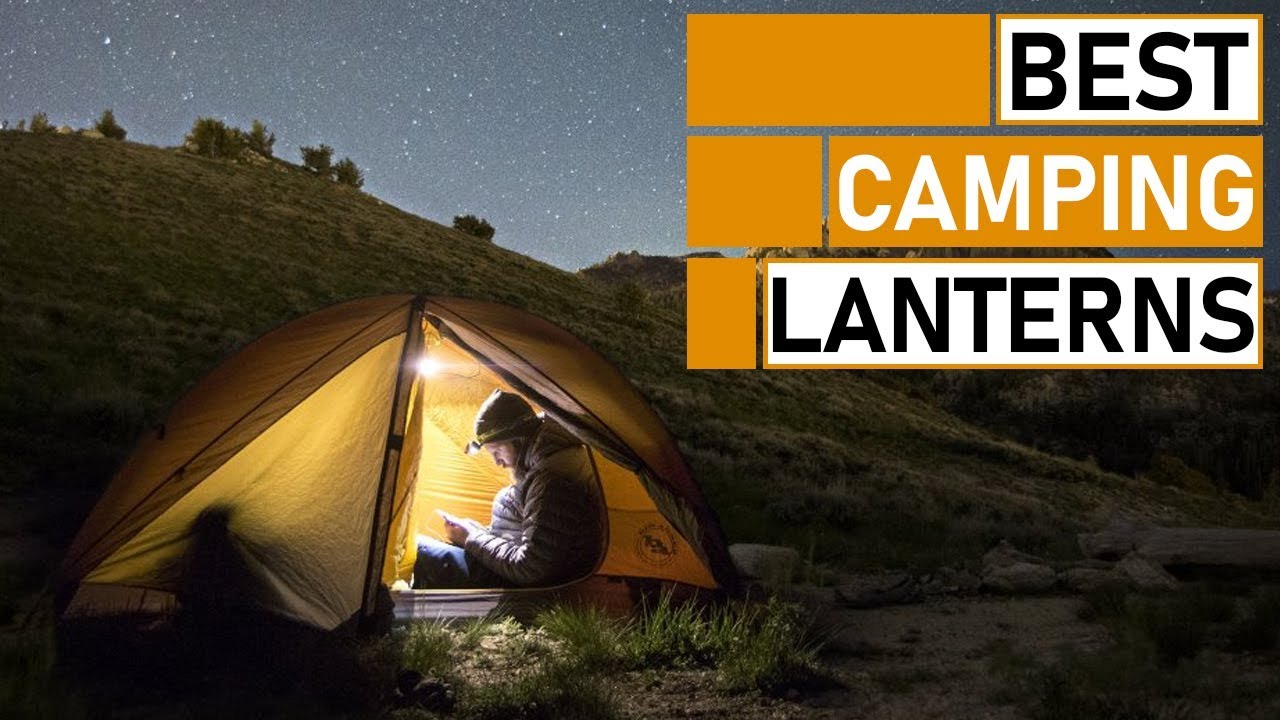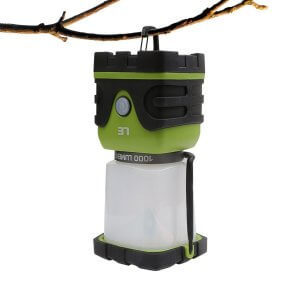
Heading out into the woods to go camping is something we can all enjoy from time to time. Today, with equipment and technology so rapidly evolving there are more options than ever for gadgets to make your camping trip more enjoyable for everyone. Camping lanterns have been around for decades and there’s a type to suit everyone’s needs for light in the wilderness. When the woods get dark, your camping lantern has your back!
Today I’m going to help you figure out exactly how to pick the best camping lantern for your next trip. We’ll talk about all the details to look for and what to avoid when buying a camping lantern for you or your family. Then, I’m going to show you a handful of my favorite camping lanterns that are easily available for you to buy when making your decision.
BEST CAMPING LANTERNS
| 1 | Coleman Premium Dual Fuel Lantern | 700 | Coleman Liquid Fuel or Unleaded Gasoline |
| 2 | Etekcity 2 Pack Portable LED Camping Lantern | 60 | AA Batteries |
| 3 | AYL StarLight LED Lantern | 600 | D Batteries |
| 4 | Streamlight Ultra-Compact Work Lantern | 540 | D Batteries |
| 5 | Lighting EVER Dimmable Portable LED Lantern | 1,000 | D Batteries |
Know what you want? Buy your camping lantern here now!
TOP-RATED CAMPING LANTERNS
EDITOR’S CHOICE – COLEMAN PREMIUM DUAL FUEL LANTERN
Maybe you’re surprised that the best camping lantern today is still what would likely have been the top pick decades ago. I guess a great design just never dies. Coleman has been making this icon gas-powered lantern for decades and little has changed. Let’s take a look at some of its best features.
Pros:
- 700-lumen output
- Burns gasoline or white gas
- 7 hours of burn time on one tank
- Dimmable
The tank has a ¼ gallon capacity (2 pints) and can burn for 7 hours. That’s 28 hours of burn time per gallon at 700 lumens of output for the (current average) price of about $2.50 in gasoline. Compared to the Black Diamond Apollo lantern which runs on AA batteries the Coleman Dual Fuel Lantern produces more than 8x as much light on high. In roughly 14 hours you’ll use 4 AA batteries in the Apollo lantern which cost $0.51 per. That’s $2.04 for batteries compared to $1.25 in gas fuel. Not to mention you’d need 8 Apollo lanterns to make nearly as much light as 1 Coleman lantern. That ends up costing you over $16 in batteries to get the same light output at $1.25 worth of gas.
With multiple times the light output of most electronic lantern competitors, you’ll need to be able to dim the lantern. Of course, you can do that, but it’s not as easy as adjusting the light modes on an electric lantern. By far the biggest drawback to the Coleman Dual Fuel Lantern is the weight and bulk. You’ll need room for both the lantern and fuel. This shouldn’t be a problem for car camping or RV camping. If you’re backpacking to your campsite, however, you’ll want to skip to our #2 lantern pick which is perfect for hikers.
Another minor drawback is that the gas lantern would be an inappropriate choice for prolonged indoor use such as tents or campers. While it is slightly harder to operate than an electronic lantern, most users will find the learning curve very short. Furthermore, while it can’t be safely used inside the tent I can’t think of a single time I went camping with just a lantern. Every hiker and camper I know take a headlamp even when there’s also a lantern, so using the headlamp inside the confines of the tent should be no issue at all when the gas lantern cannot be brought inside.
Since the lantern can be operated on both gasoline and white gas (Coleman camping fuel) finding fuel will be no harder than finding batteries. Camp stores always carry white gas, and gasoline is available on nearly every corner. Batteries are equally prolific and for that reason, I think both gas and electric lanterns are tied for “ease of finding fuel”.
The Coleman Dual Fuel Lantern is strides ahead of the competition in light output and cost efficiency. Except for situations where the weight or bulk of the lantern becomes a critical drawback, I think the Coleman Dual Fuel Lantern makes a clear-cut winner in the best camping lantern category.
CAMPING LANTERN BUYERS GUIDE
There are tons of factors at play when picking out a camping lantern. Fortunately, it’s not a particularly high-stakes purchase. Let’s find out what criteria you really need to be concerned with.
POWER SOURCES
It used to be that the old gas-burning lanterns with these cool mantles that blaze brighter than the sun were the only option. Today LED bulbs and improved batteries make electronic lanterns more viable than ever. Generally speaking, there are two main power sources for your camping lantern.
- Gas powered lanterns
- Electronic lanterns
When choosing a power source for your lantern you need to think ahead a bit to see what makes the most sense for you. Things that will affect your decision would be:
- Access to batteries or electrical outlets
- Remoteness of location
- The danger of burning a gas lantern in enclosed spaces
- Availability of gas fuel
- Packability for hiking
Assuming that you’re taking a camping trip to the local RV park and that’s where you’ll camp 99% of the time, chances are an electric lantern or light would be fine for you. You’ll have easy access to batteries or electrical outlets to recharge. If you’re heading into the deserts of Southern Utah for a three-week trip and won’t see another human… you might be better off with a gas-powered lamp. Just carry an extra can of fuel and there’s no need to worry about finding batteries or electricity in the middle of the sandstone desert.
Gas lanterns are not particularly dangerous for their fire hazard, although a fuel spill is possible. The more immediate consideration for most campers is to think about where you’ll have the lantern. Gas lanterns can emit toxic fumes that wouldn’t be good to burn inside a small space like a tent. But having your gas lantern sitting on the picnic table while you prepare burgers off the grill would be just fine.
The last important factor I will mention in this section is the viability of packing your lantern. If you’re planning on doing backpacking trips to your campsite, weight and size become primary concerns. In this case, you’ll probably be forced to choose an efficient LED battery-powered camping lantern.
EMBRACING YOUR INNER LUMBERJACK
This might seem trivial but it’s worth mentioning. Most of us enjoy camping at least in part for the sense of rustic connection to a more primitive way of doing things. Heading out camping means chopping firewood, cooking simple meals, and lighting fires. You might prefer a gas-powered lantern simply for the rustic, antiquated aesthetic it provides over a more modern lantern. There’s something fun about pulling out the old gas lantern and lighting it up as you wait for the mantles to roar into blazing light. Keep that in mind while shopping.
COST OF OPERATION
Most of us won’t really find this to be a huge factor. However, it does matter if you’re using your lantern a ton. Who might be using their lantern enough to make operating costs matter? If you’re using it for off-grid living and would be burning or operating the lantern every single night for several hours, it might matter. Or maybe you just need light for outside work in the evenings on a regular basis. Either way, if you plan to use your lantern frequently keep operating costs in mind.
The following are the types of camping lanterns organized by operating costs.
- Battery Powered (Most Expensive)
- Gas Powered
- Plug / Outlet Powered (Least Expensive)
By far the most expensive lanterns to operate are battery-powered. Batteries, as we all know, are quite pricey and honestly a bit wasteful if the lantern will be operated frequently. The solution to this is to find a lantern that is battery-powered but has a plug adapter optional for times when you’ll be running it near a power source. Rechargeable battery lanterns are also a great option to mitigate costs.
Gas-powered lanterns will be more affordable than battery-powered lanterns, although the gas still will cost a bit. For most users, gas will be more economical than battery. Plug and outlet lanterns are ideal, especially if they also have an internal rechargeable battery. Running an efficient LED lantern off of wall power will cost very little to operate for any amount of time. Wall power also provides a lot more “juice” to power brighter lanterns than batteries. This gives you the portability of batteries with the option to take advantage of wall power for extended use periods, such as at a powered campsite.
UPFRONT COSTS
You know that old saying, “you get what you pay for”? Well, it might be true to a large extent where camping lanterns are concerned.
Price is in fact a crucial consideration for purchasing any new item for most folks. If it’s out of your price range, it’s just not going to be an option. However, since camping lanterns as a category don’t usually feature nosebleed price tags, it’s likely a relatively minor concern when choosing a camping lantern.
The camping lanterns I’m going to recommend are first and foremost prioritized based on their performance, fuel type, and quality. Where two camping lanterns are nearly identical, the price can become a tie-breaking factor.
ALTERNATIVE CAMPING LANTERN FUNCTIONS
Many camping lanterns, particularly electronic LED lanterns feature dual modes or features. Some may slide to become a single beam flashlight. Others have legs that fold out or a hook for hanging. Because the features vary so widely I’ll only address a few here.
Be careful to avoid “gimmicky” features that add no real value or actually detract from the function of your camping lantern.
- Folding legs are a camping lantern feature common on electronic lanterns. I love this feature as it helps get the light up in the air when sitting on a table, thus spreading over a wider area.
- Hanging hooks are a must-have feature on any camping lantern. Lanterns are by far the most effective when suspended over an area so they can wash the location in light.
- Flashlight conversion is a feature that can be hit or miss. On high-quality LED lanterns this feature can sometimes be desirable. Cheaper quality lanterns with this feature tend to be neither good lanterns nor good flashlights.
- Brightness adjustment is well worth your time. Whenever available I would prioritize this feature. It allows you to adjust LED lights to varying levels of intensity. You can use this feature to balance battery or fuel consumption against how much light you need. Of course, gas-powered lanterns inherently are all adjustable.
- Colored lights are only available on electronic lanterns. Generally red is the alternative color which can be used to create just enough light to see without harming your eyes’ ability to see at night. Red lights are less harsh and allow you to retain your “night vision” when used in total darkness. This is a feature that I find helpful to avoid blinding myself and others late at night.
WEIGHT AND BULK
These factors are crucial, but only in a few situations. The weight and bulk of your camping lantern matter a lot if you’ll be hiking or backpacking to your camping location. For those driving to a campsite weight and bulk really don’t matter at all in most cases.
So, if you’re packing the lantern in a cubby of your RV then don’t worry about weight or bulk so much. If you’re hiking 10 miles to your campsite, you’ll definitely want to avoid heavy, bulky lanterns.
Compact battery-powered camping lanterns can be quite lightweight, and even relatively efficient. When searching for these lanterns you’ll want to keep an eye on backpacking lanterns like the Black Diamond Apollo Lantern which comes in at just 7.8 ounces. It’s also collapsible and has folding legs to make it fit into a backpack with ease.
Before you go searching for the best camping lantern that meets your needs, ask yourself if weight and bulk are a priority. Don’t forget to keep in mind the added weight and bulk of any replacement batteries if you’re backpacking or hiking in remote locations for many days or weeks on end.
LUMENS AND LIGHT OUTPUT
Lumens are a measure of how much light a source puts out. You’ve probably seen this on lightbulbs in your house. For reference, a common LED light bulb for your house light might be around the 800-lumen mark – though they can vary widely! A common candle might have an average of about 12 lumens of light power.
Let’s take a look at the lumen output for LED camping lanterns. Two of my favorites are the Black Diamond Apollo and the Princeton Tec Helix.
- Black Diamond Apollo – 80 Lumens (Max)
- Princeton Tec Helix – 150 Lumens (Max)
Meanwhile, gas lanterns have the distinct advantage of producing significantly more light output. Let’s compare the lumen output to the distinctive Coleman Dual Fuel Lantern.
- Coleman Dual Fuel Lantern – 700 Lumens (Max)
As you can see, gas-powered lanterns generally have the capability to produce a much greater amount of light. While light output isn’t the final factor in deciding what makes the best camping lantern, creating light is certainly a crucial factor in how well any lantern performs its job.

